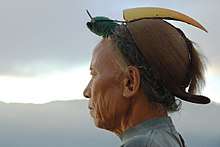Nyishi people
 A Nyishi man with a hornbill headdress | |
| Total population | |
|---|---|
| 249,824[1] (2011 census) | |
| Regions with significant populations | |
|
| |
| Languages | |
| Nyishi | |
| Religion | |
| Christianity, Animism |
The Nyishi are the largest ethnic group in Arunachal Pradesh in north-eastern India. In Nishi, their traditional language, Nyi refers to "a man" and the word shi denotes "a being", which combined together refers to a human being. They are spread across seven districts of Arunachal Pradesh: Kra Daadi, Kurung Kumey, East Kameng, West Kameng, Papum Pare, parts of Lower Subansiri and Kamle district. They also live in the Sonitpur and North Lakhimpur districts of Assam.
Their population of around 300,000 makes them the most populous tribe of Arunachal Pradesh, closely followed by the combined tribes of the Adi and Galo, who were the most populous in the 2001 census. The Nyishi language belongs to the Sino-Tibetan family, however, the origin is disputed.
Polygyny is prevalent among the Nyishi. It signifies one's social status and economical stability and also proves handy during hard times like clan wars or social huntings and various other social activities. This practice, however is diminishing especially with the modernization and also with the spread of Christianity. They trace their descent patrilineally and are divided into several clans.[2]
Economy
The Nyishi are agriculturalists who practice jhum, known as rag in Nishi, which is a form of shifting cultivation. The principal crops raised include paddy (unmilled rice), tapio (maize), mekung (cucumber), takie (ginger), aange (yams) and temi (millet). Rice is the staple food of the people, supplemented by fish, meat of various animals, edible tubers and leafy vegetables. Before a Western market economic system arrived, they used a barter system. They greatly valued the generalized reciprocity and also balance reciprocity in their economic system. A locally-made drink known as apong (the two types of apong: pone, made of rice, and poling which is made of millet) is served at every social gatherings and important events. The Nyishis are typically fond of it. Traditional ways of preparing them include steaming, roasting and smoking. Recently they have been forced to move towards a market based exchange economy.
Attire
Traditionally, Nyishi plaited their hair and tie it neatly at the forehead with Tibetan thread. A brass skewer passes horizontally through the tied hair. Cane rings were worn around the waist, arms and legs. Men wore a cane helmet surmounted with the beak of the great Indian hornbill. The usage of actual hornbill beaks is discouraged these days due to tough wildlife protection laws since the great Indian hornbill is a protected species and generally due to growing awareness among the people as well. Nowadays It is being supplemented by beaks made of cane or other materials and the entire headgear/cane helmet itself is readily available in the market for purchase. Additional decorations varied depending upon the status of the person and were symbols of manly valor.
The clothing of the men consists of sleeveless shirts made from thick cotton cloth, striped gaily with blue and red together with a mantle of cotton or wool fastened around the throat and shoulders. Strings made of beads in varying sizes and colours were also worn, mainly for decoration purposes and to show the wearer's status. They also carry a Machete called dao (uriuk, chiighee in Nyishi) (short sword) and a knife (Ryukchak) in a bamboo sheath that are mostly covered with animal furs. Their armament consists of spear with iron-head, a large sword (dao), and a bow and arrows which are tipped with poison (umiyu). During war both the chest and back are covered with shields made from sabbe buffalo hide, and over it they wear a black cloak made of indigenous fibre.
The Nyishi women generally wear a sleeveless mantle of striped or plain cloth, its upper part tucked tightly over the breast and enveloping the body from the armpits to the centre of the calves. A ribbon is tied at the waist. A girdle consisting of metal disks and cane garters is worn at the waist. Their hair is parted in the middle, plaited and tied into a chignon just above the nape. Their ornaments include multicolored bead necklaces, brass chains, metal bells, huge brass or silver earrings and heavy bracelets of various metals.
Religion
Nyokum is the festival celebrated by the Nyishi people, which commemorates their ancestors.
Most Nyishis have been converted to Christianity by Christian missionaries in the 1970s, particularly in the Papum Pare region and Christianity is the major religion among the Nyishis. Small groups of Hindus also exist among the Nyishi.
The hornbill issue
The Nyishis, who traditionally wear cane helmets surmounted by the crest of a hornbill beak (known as pudum, padam), have considerably affected the population of this bird.
Several organizations, such as the Arunachal Wildlife and Nature Foundation and the Wildlife Trust of India, have been trying to stop the Nyishi hunting these birds in order to protect them from extinction. Nature reserves, such as the Pakke Sanctuary, are being set up to protect the birds, while artificial materials, such as fiberglass, have been introduced as an alternative to the hornbill beak in Nyishi dress.
References
- ↑ "A-11 Individual Scheduled Tribe Primary Census Abstract Data and its Appendix". www.censusindia.gov.in. Office of the Registrar General & Census Commissioner, India. Retrieved 2017-11-03.
- ↑ India Ministry of Information and Broadcasting Published by Publications Division, Ministry of Information and Broadcasting, Govt. of India (1979). Arunachal Pradesh. pp. 15–6.
External links
| Wikimedia Commons has media related to Nyishi people. |